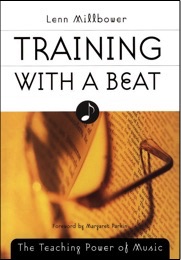Training With A Beat Synopsis
Training With A Beat: The Teaching Power of Music, written by Lenn Millbower, the Learnertainment® Trainer and former Disney training leader, is divided into three sections, defining the why, what, and how of music:
Part One - Music Explored examines why people learn to music.
Part Two - Music Explained addresses what music is.
Part Three - Music Applied focuses on how to use music in learning situations.

MUSIC EXPLORED
Music Explored establishes the framework for our exploration of the musical beat. It examines underlying factors that will become useful in later chapters and discovers the connection between human and musical origins.
In Chapter One, Music and You, we will examine the personal relationship between human beings and music, discover the pervasiveness of music in today's world, and discuss the multitude of effects music has on us.
Chapter Two, The Birth of Music, explores the beginnings of our musical heritage. It examines the ways in which music and language may have intertwined at the beginning, and, in so doing, help us begin our exploration of the teaching power of music.
Chapter Three, The Triune Brain, discusses Paul MacLean's theory of human brain evolution, an evolution that may have coincided with the development of music. MacLean's theory offers possible explanations for music's ability to move us both emotionally and intellectually.
In Chapter Four, Left Right Left, we build on the work of Roger Sperry. The discussion examines the difference between the brain's left and right hemispheres. You will discover ways in which the left hemisphere's rationality and the right hemisphere's creativity partner to hear, and enjoy music.
Brain waves are the subject of Chapter Five, Brain Vibrations. The cycle time of brain's waves play an important function in our daily lives, and are one of the sources of music's teaching power. You will discover how vibrations emanating from a person's brain respond to music, encouraging learning.
Chapter Six, Musical Intelligence uses both Howard Gardner's Multiple Intelligences and Daniel Goleman's Emotional Intelligences theories as departure points for two discussions; music's function as a core intelligence, and music's emotionality and the importance of harnessing emotions while training.
Chapter Seven, Music and Learning, discusses the effectiveness of music-based learning throughout human history; looking for trends, factors, and other specifics that help establish basic guidelines for training with a beat.
MUSIC EXPLAINED
The next section, Music Explained, provides a lay-person's explanation of musical theory. It avoids lengthy theoretical discussions and instead focuses on information a trainer requires to intelligently select training music.
Chapter Eight, The Musical Pulse, examines pulse, rhythm, beat, and meter. It explains, in the clearest terms possible, what different meters are, and what those distinctions mean for the training beat.
The difference between sound and music, and a definition of when a sound actually becomes music is the focus of Chapter Nine, The Musical Sound. An overview of musical terminology required for training placement is offered.
Chapter Ten, Musical Styles, explores genres of music available to trainers. It begins the process of applying music to the classroom, offering a lengthy, but clear explanation of classical music, as well as other genres, leading toward an understanding of effective music placement within training activities.
MUSIC APPLIED
Music Applied is the final section. It gets to the heart of musical training, offering explanations, examples, and tools for harnessing the teaching power of music.
Chapter Eleven, Teaching With Music, provides specific examples of music placement, along with a series of guidelines for the learning principles involved. A continuing vignette of one trainer's struggles while teaching diversity to a reluctant audience provides additional insight into the musical training process.
Chapter Twelve, Teaching With Lyrics, explores the important aspects of lyrical music. Songs with lyrics, although extremely effective, require a separate set of parameters. This chapter offers simple rules for using songs with lyrics.
Chapter Thirteen, Musical Precautions, discusses the potential pitfalls of teaching with music. Among the subjects explored are participant expectations, cost, technical problems, and legal issues.
Chapter Fourteen, Training With A Beat, brings the discussion to a close with some final observations about the teaching power of music.
MUSIC PLACEMENT LISTINGS
Recordings from fifty years (1950-2000) of popular music have been cross referenced in three different ways:
★ By artist with each artist, and their song, listed alphabetically•
★ By song title with each selection, and the artist who recorded it, listed alphabetically
★ By learning function with songs grouped according to their possible usage.
★ Some of the topics include Change, Career Development, Communications, Diversity, Leadership, sexual Harassment, Time Management, and Technical Training.
Learn How to Apply Music to Enhance Engagement and Accelerate Learning
